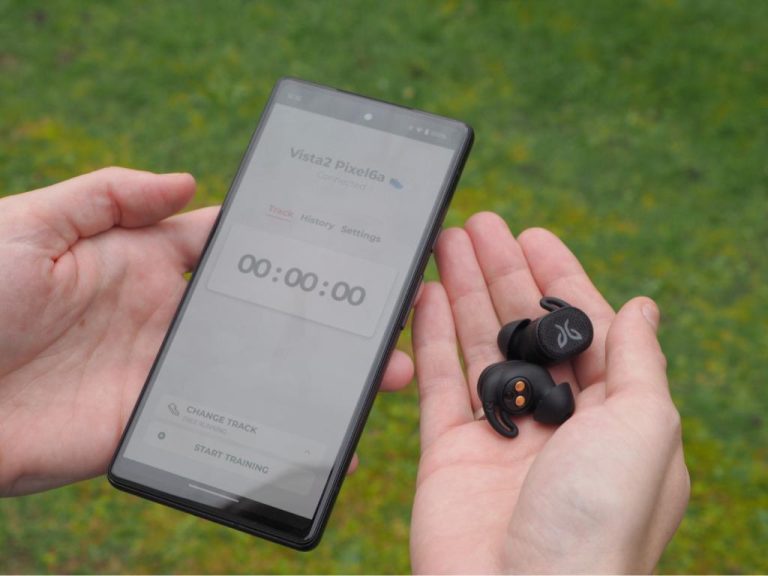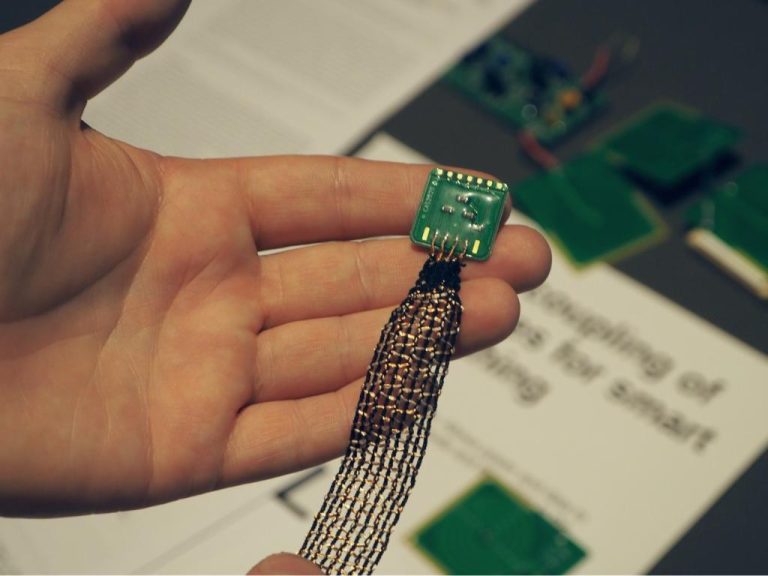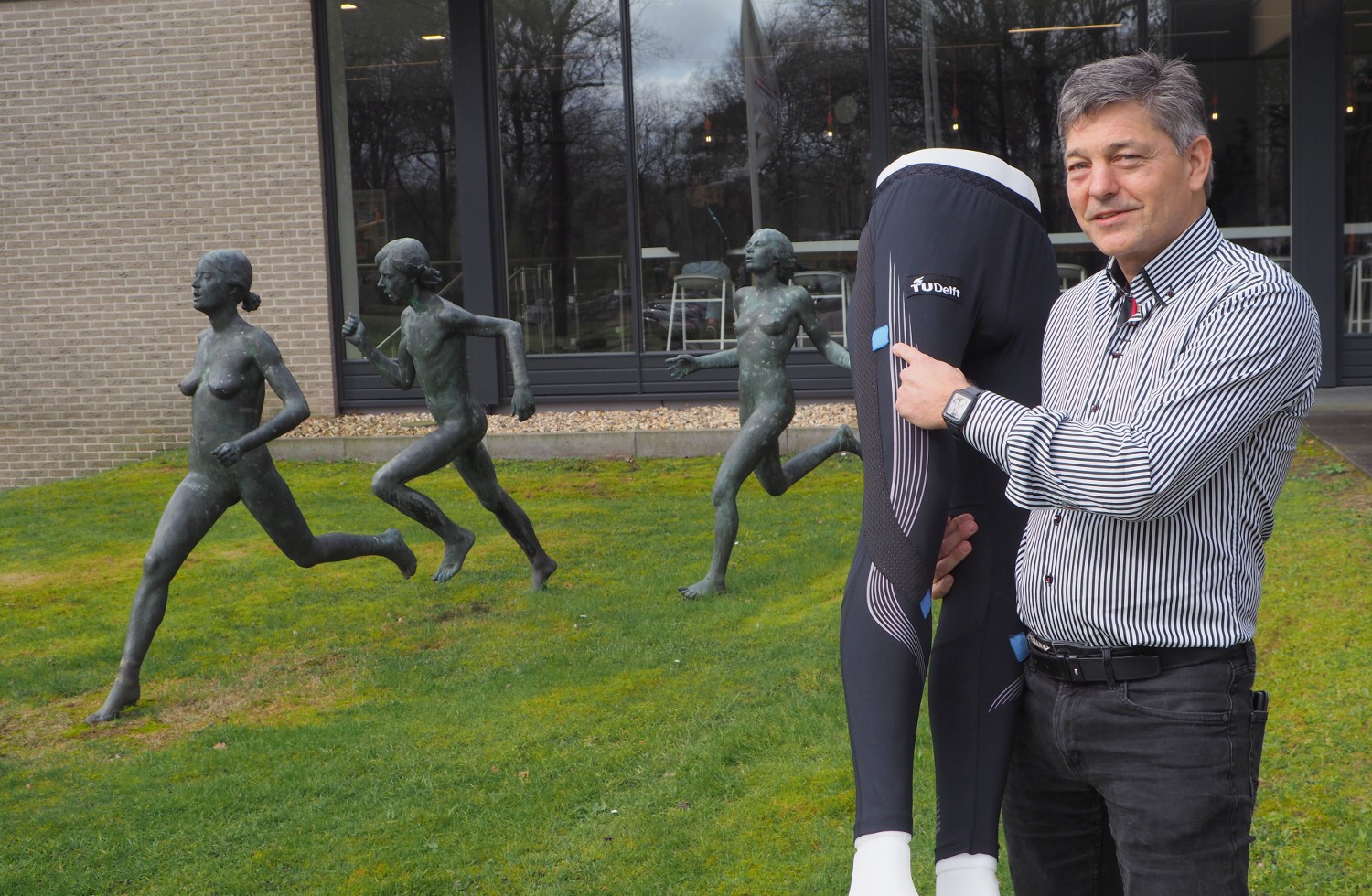The NWO’s CAS research programme aims to help people engage in injury-free sports. Recently, the participants met at Papendal. What has been achieved in five years?
IDE-Professor Kaspar Jansen points at one of the five sensors integrated into the sports trousers. (Photos: Jos Wassink)
Injuries are not only annoying for the athletes, they are also often the reason people stop doing sports, says Professor Frans van der Helm (Faculty of Mechanical, Maritime & Materials Engineering, 3mE). As the programme leader, he attended the closing meeting of the NWO’s Citius Altius Sanius (Faster, Higher, Healthier) Perspective programme on Thursday, 30 March 2023 at Arnhem’s Papendal sports hall. Injuries also involve costs. Besides the direct costs of treatment, there are also absentee costs because people who sustain an injury on the sports field on Sunday do not come to work on Monday. Van der Helm mentions the figure of EUR 5 billion a year.
Against this, there is a research budget totalling EUR 6.2 million. Several people, including 12 PhD students and two postdocs, worked on the research over the past five years. Six universities, two universities of applied sciences, 28 companies and 11 sports associations joined. One hundred and fifteen people attended the closing day in Arnhem to share the results. In the foyer, the various sub-areas were divided among six stands: running, football & hockey, baseball & tennis, fitness & power training, cycling, and cooling. According to one of the communication advisors, the first two topics have the most practical applications.
Running
 The app RunningBuddy analyses one’s running style and helps to improve that.
The app RunningBuddy analyses one’s running style and helps to improve that.
The RunningBuddy is a digital running coach. Earplugs produced by the Dutch company Dopple contain accelerometers which show step frequency and step height. The RunningBuddy distinguishes four running styles: bounce (low tempo, high jumps like a springbok); push (high tempo, little height difference like an ostrich); stick (low tempo, little height difference like a polar bear); and, hop (high tempo, big height difference like a rabbit). The app takes about three minutes to analyse a person’s running style and then starts giving directions to change it by about 5% in terms of pace or ground contact time.
Does it prevent injuries? Not directly, say the researchers in the booth, but it does introduce runners to a slightly different running style that may be faster or less strenuous. Dopple’s website puts it like this: ‘to help guide you in exploring different running styles as well as informing you on your overall performance’. To prevent injuries, it should assess more information about a person’s fitness, running history and goal. The RunningBuddy does not yet provide these.
Sensor trousers
 One of the five built-in sensors, sensitive for translations and rotations in all three directions with washable and extremely flexible wiring.
One of the five built-in sensors, sensitive for translations and rotations in all three directions with washable and extremely flexible wiring.
Football and hockey are notorious for knee injuries. To get a better grip on this, Professor Kaspar Jansen’s group (Faculty of Industrial Design Engineering, IDE) developed sensor trousers. The long model contains five sensors: one on the back, two on both upper legs and another two on both lower legs. The shorts have three sensors. Each sensor records accelerations and rotations in three directions and transmits these to a box the size of a mobile phone on the athlete’s back. Apart from the data box, the shorts are completely flexible and washable, as is the wiring. For now, the motion data in the box is stored on an SD card, but the intention is to transmit the data to, say, the coach or medical staff on the sidelines. And what would they do with the data? They could monitor the peak intensity per player or see the build-up of fatigue, suggests PhD student Bram Bastiaansen (Movement Sciences at the University of Groningen). You can even imagine a little meter indicating each player’s fitness level or remaining energy levels in green and red. The sensor shorts could thus complement Inmotio, a sports tracking system that keeps track of the position of all players during a match.
Push & Pull
“The key question, of course, is if this programme has prevented even one injury?” said Van der Helm. He left the question unanswered, but he did say that the development from a prototype to a product on the market will take at least as long as the development of the prototype itself. In other words, the programme that was concluded is now actually halfway through.
Professor Peter Beek, Human Motion Sciences at the Free University of Amsterdam, agrees. He would like to see an open research programme, CAS 2.0, in which the focus shifts from sensors to performance improvement and injury prevention.
The link between performance improvement and injury prevention was not entirely clear. One example is the baseball application called PitchPerfect which uses two sensors (on the hip and the chest) to record the movement of a pitcher. It took 10 years to develop. “If only we had this before,” said former Olympian pitcher Diegomar Markwell. Despite initial scepticism, Markwell recognises that data can help both coach and athlete get a better understanding of the player’s pitching technique. In addition, Markwell argued that technique improvement and injury prevention go hand in hand, but he did not elaborate on that.
Van der Helm talks about push and pull in this context. The push is what the technology has to offer, the pull represents the athlete’s needs. A successful application bridges the gap between the two. And sometimes the athlete’s needs lie in a completely different area than the developer had envisaged years earlier. Who would have expected, for example, that white trainers, developed as cheap footwear in the 19th century, would become a fashion statement?
- You can read more about the NWO’s Citius Altius Sanius perspective programme here. The running coach RunningBuddy has a website, as does the manufacturer of earplugs Dopple. Finally, Inmotio is a system that tracks players live on the pitch.
Do you have a question or comment about this article?
j.w.wassink@tudelft.nl


Comments are closed.